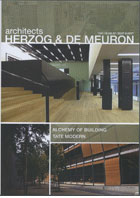
Architects Herzog and de Meuron: Alchemy of Building and Tate Modern 2008
Distributed by Microcinema International/Microcinema DVD, 1636 Bush St., Suite #2, SF, CA 94109; 415-447-9750
Produced by Al Castello
Directed by Beat Kuert
DVD, color, 77 min.
Sr. High - Adult
Architecture
Date Entered: 01/30/2009
Reviewed by Ronald Saskowski Jr., ASRC Management Services, Atlanta, GA
“Each building is a solution to a unique set of problems” -- Sir Nicholas Serota, Director of the Tate ModernThe quote from Sir Nicolas perfectly describes the principles and style of the architects Herzog and de Meuron. The DVD contains two films, the first, Alchemy of Building takes the viewer on a tour of completed projects in Switzerland, France, England and Germany, including the Tate Modern. The Tate Modern is more fully explored in the second selection of the DVD, Tate Modern.
Alchemy of Building is an audio and visual masterpiece. There is just enough audio to appropriately explain the projects but not too much allowing the architecture can speak volumes itself. Beat Kuert brilliantly combines a mix of color, black and white, text and images to make for an incredibly stimulating adventure. The piece highlights the remarkable talent of Herzog and de Meuron, showing how they approach each project as if they have never designed before. Cookie cutter buildings are not part of the equation for this duo. They posses the ability to look at a project and its intended function and then design based on that.
A narrator translates into English through voiceovers enabling the viewer to concentrate on the architecture. The narrator is well spoken and is easily understandable. The sound balancing of this feature seems to be a bit off. The volume required adjustment throughout the film.
Tate Modern (the second feature on the DVD) provides a glorious tour of the Tate Modern Art Museum in London. Conversations about the project with the architects and the director cover all the design elements to produce a well rounded film.
The piece reflects the principles of Herzog and de Meuron and their ability to design to solve a specific problem. The museum was once a power station that was abandoned. The director saw the potential of the facade and Herzog and Gugger (a member of the firm) realized that potential.
The cinematography of each feature is very professional and shows the talents of the producer and director. Music selections for both features are appropriate to the topic.
Although neither of these films details the personal attributes of the architects themselves, the viewer is able to realize who they are through their work.
These films are highly recommended for colleges and universities with programs in architecture. High school architecture classes would also do well to have this available for their students. Architectural societies and organizations should have this available for their membership.